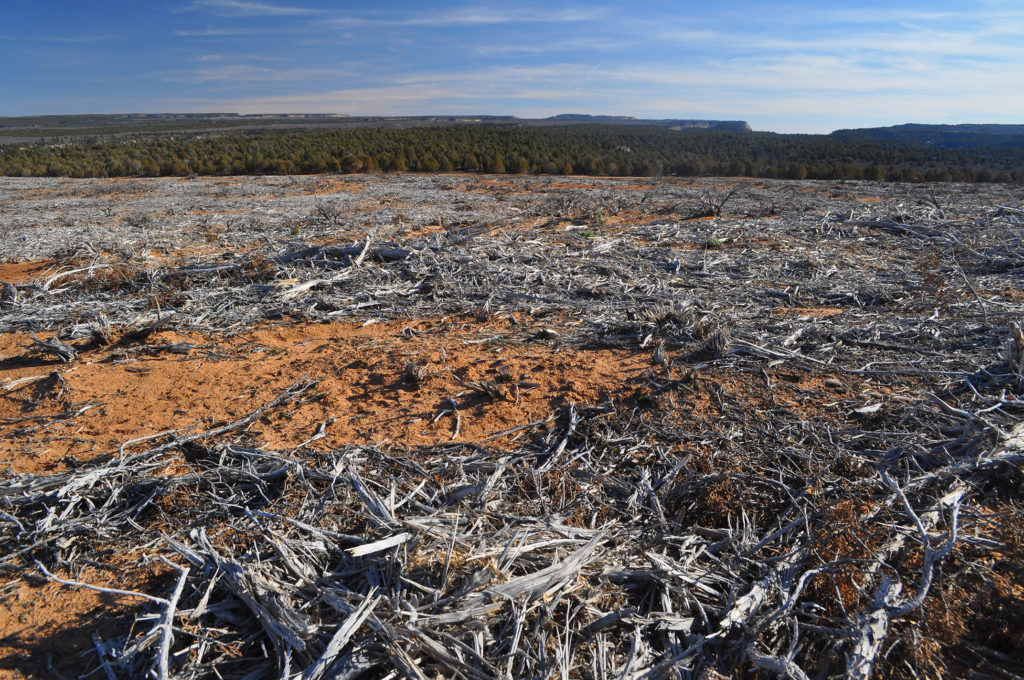Comments due by April 13th, 2020!
The Bureau of Land Management (BLM) spends tens of millions of taxpayer dollars destroying hundreds of thousands of acres of native pinyon pine and juniper forests throughout the West each year. In recent years, public input has stopped many of these controversial projects or helped the BLM make better, more scientifically-sound vegetation management decisions that leave pristine, sensitive wilderness-quality lands and habitat intact.
Now, despite the critical role of public input and oversight on these controversial vegetation removal projects, the BLM is proposing a new categorical exclusion under the National Environmental Policy Act (NEPA) that would allow up to 10,000 acre projects to mechanically remove pinyon pine and juniper trees on public lands with no environmental analysis, public accountability, or public input.
We must use this opportunity to remind the BLM why public input is crucial to a rational and science-based decision-making process, provide evidence that the environmental effects of vegetation removal projects vary significantly from project to project, oftentimes causing significant long-term harm to native ecosystems, and make the public voice heard.
Comments on the proposed categorical exclusion are due April 13th, 2020. Click here to submit comments through our online action center.
When writing your comments, please consider the following points:
- 10,000 acre projects are an extremely unreasonable size to categorically exclude from NEPA and public review. This area is larger than many cities. Congress in the past has called for agencies to establish categorical exclusions for some projects up to 4,500 acres in size. BLM’s proposed categorical exclusion is more than double that, with very few limitations on where, when, and how treatments can be conducted.
- The best available science shows that these projects do have significant environmental effects, making any blanket determination that future projects need not go through the NEPA process because there are no significant environmental effects wildly inappropriate.
- BLM has misrepresented available scientific research on the effects of these projects in its categorical exclusion proposal, erroneously concluding they have a net positive effect on the ecosystem. This completely excludes science showing that mechanical pinyon pine and juniper removal is overall very harmful for woodland-dependent species, including migratory birds whose populations are already in drastic decline.
- BLM should not be able to categorically exclude any projects in National Monuments, Areas of Critical Environmental Concern, Wilderness Study Areas, or other special-status public lands. There are many proposed vegetation removal projects in recent years that were removed from these sensitive areas because of public input and engagement. It is improper for BLM to be able to plan, approve, and execute projects using heavy machinery to clearcut native forests in these special management lands with no public oversight and without robust, site-specific environmental analysis.
- These projects help accelerate climate change by causing large-scale surface disturbance that increases desertification, contributes to atmospheric dust levels, and removes valuable forest carbon sinks. BLM must continue to do project-specific, public, NEPA analysis for pinyon pine and juniper removal projects because of their potential contributions to climate change.
- BLM has not demonstrated that it has adequately monitored past vegetation removal projects to ensure that the treatments do not cause significant, long-term damage to overall ecosystem health by disturbing and destroying biological soil crust or spreading invasive species like cheatgrass. BLM must provide long-term monitoring data from past projects to demonstrate their success before categorically excluding future projects from NEPA. BLM must make this data publicly available.
- BLM has not provided any criteria or guidelines in the proposed CX to determine what qualifies as sage-grouse or mule deer habitat, and because there will be no public process, the BLM will not need to justify these determinations. Therefore, the BLM could ostensibly use the proposed CX to remove 10,000 acres of forest wherever it wants with no public accountability. Distressingly, the public may not even know these large-scale projects were happening until after they were completed and the deforestation was irreversible.
Please consider all of these points as you make your comments, and make sure to add your own! Tell the Bureau of Land Management why large-scale mechanical removal of pinyon pine and juniper forests across the west continues to be a very significant action deserving of careful environmental review and public input.
>> Click here to submit comments through our online action center (personalize if possible)
>> Click here to submit comments via the BLM’s web portal (use points above to craft a message in your own words)


